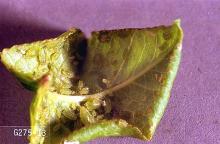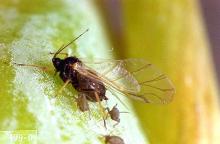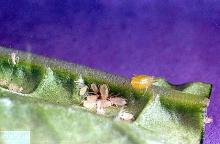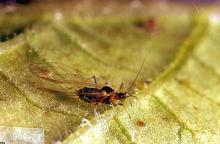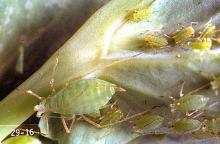Includes
Bean aphid (Aphis fabae)
Green peach aphid (Myzus persicae)
Pea aphid (Acyrthosiphon pisum)
Potato aphid (Macrosyphum euphorbiae)
Pest description and crop damage The green peach aphid is slender, dark green to yellow, and has no waxy bloom. It is primarily an early year pest. Green peach aphid infestations may result in wilting.
The potato aphid has both a pink and green form. It is a larger aphid. High potato aphid populations can distort leaves and stems, stunt plants, and cause necrotic spots on leaves. These aphids also secrete a large amount of honeydew that promotes development of sooty mold on foliage and fruit. The bean aphid is dark olive green to black with light-color legs. It is usually more of an early year pest. The pea aphid, common on peas, is a relatively large, green, somewhat shiny species.
Biology and life history
See:
Common Pests of Vegetable Crops
Pest monitoring Check fields frequently after seedlings emerge. If aphids become numerous, increase frequency of sampling. Aphids often are concentrated in hot spots or near the field margin. Note the presence of any hot spots, but avoid sampling only those areas. Also, be sure to look for evidence of biological control; i.e., the presence of predators, parasitoids (aphid mummies), and pathogens. Aphid flights are most common during periods of moderate temperatures (60° to 80°F). Monitor fields particularly closely during April and May.
Management-biological control
Many parasitoids and predators attack aphids. Among the more common predators are lady beetles and their larvae, lacewing larvae, and syrphid fly larvae. Populations of green peach aphids are reduced in winter by the insect pathogenic fungus Entomophthora aphidis.
Monitor the proportion of aphid mummies relative to unparasitized aphids and the numbers of predators such as lady beetles. If the proportion of mummies is increasing, or predators appear to be gaining control, and aphid populations are not yet damaging, avoid sprays that will disrupt these natural enemies. Most materials available for aphid control are highly disruptive of natural enemy populations.
Management-cultural control
Destroy infested crops immediately after harvest to prevent dispersal. Destroying weed hosts late in the year may help destroy overwintering populations. Aphid populations tend to be higher in crops that are fertilized liberally with nitrogen. Roguing diseased plants early may help slow the spread of aphid-vectored diseases. Row covers can be used to protect high value crops.
Home gardeners can often get effective control by washing aphids with a strong stream of water.
Research in California has shown that silver- or aluminum-colored mulches repel winged aphids. These may reduce the rate of colonization by winged aphids significantly and delay the buildup of damaging numbers of aphids by 4 to 6 weeks.
Management-chemical control: HOME USE
Apply control measures when aphid first appear, and repeat applications at 8 to 10 day intervals as needed.
- azadirachtin (neem oil)-Some formulations are OMRI-listed for organic use.
- bifenthrin (as a mix with zeta-cypermethrin)
- carbaryl
- cyfluthrin
- horticultural oil-Some formulations are OMRI-listed for organic use.
- imidacloprid
- insecticidal soap (may require several applications)-Some formulations are OMRI-listed for organic use.
- malathion
- plant essential oils (peppermint, rosemary, etc.)-Some have demonstrated efficacy. Some formulations are OMRI-listed for organic use.
- pyrethrins (often combined with other ingredients)-Some formulations are OMRI-listed for organic use.
- zeta-cypermethrin
Management-chemical control: COMMERCIAL USE
- alpha-cypermethrin (Fastac EC) at 0.008 to 0.025 lb ai/A. PHI 1 day. REI 12 hr. Retreatment interval 4 days. Do not exceed 0.075 lb ai/A per season. Leaves cannot be used for food or feed.
- Beauveria bassiana (Mycotrol ESO) at 0.25 to 1 quart/A. PHI 0 days. REI 4 hr. Some formulations are OMRI-listed for organic use.
- bifenthrin/zeta-cypermethrin (Hero EW) at 0.04 to 0.1 lb ai/A. PHI 1 day. REI 12 hr. Retreatment interval 7 days. Do not exceed 0.45 lb/A per season. Leaves cannot be used for food or feed.
- bifenthrin (Brigade WSB) at 0.08 to 0.1 lb ai/A. PHI 1 day. REI 12 hr. Retreatment interval 7 days. Do not exceed 0.4 lb ai/A per year.
- Burkholderia spp. (Venerate XC) at 2 to 4 quarts/A product. PHI 0 days. REI 4 hr. OMRI-listed for organic use.
- Chromobacterium subtsugae (Grandevo) at 0.6 to 0.9 lb ai/A per 100 gal. PHI 0 days. REI 4 hr. OMRI-listed for organic use.
- flonicamid (Beleaf 50SG) at 0.062 to 0.089 lb ai/A. PHI 3 days. REI 12 hr. Do not exceed 0.267 lb ai/A per season. Limit 3 applications. Retreatment interval 7 days.
- flupyradifurone (Sivanto 200SL) at 0.09 to 0.13 lb ai/A. PHI 7 days. REI 4 hr. Retreatment interval 10 days. Do not exceed 0.365 lb ai/A per season. Do not harvest leaves for livestock feed. Washington only.
- imidacloprid (Admire Pro) at 0.16 to 0.38 lb ai/A soil; 0.044 lb ai/A foliar. PHI 7 days foliar; 21 days soil. REI 12 hr. Do not exceed 0.38 lb ai/A soil or 0.13 lb ai/A foliar per season. Retreatment interval 5 days, foliar. Do not exceed 1 treatment per season, soil.
- insecticidal soap (M-Pede) at 1 to 2% solution. Potassium salts of fatty acids. See label for gal/A. PHI 0 days. REI 12 hr. Some formulations are OMRI-listed for organic use.
- malathion (Malathion 5) at 1.25 lb ai/A. PHI 7 days. REI 12 hr. Retreatment interval 7 days. Limit 3 applications. Washington only.
- sulfoxaflor (Transform WG) at 0.023 to 0.047 lb ai/A. PHI 7 days. REI 24 hr. Limit 4 treatments. Do not exceed 0.266 lb ai/A per year
- thiamethoxam (Actara) at 0.023 to 0.047 lb ai/A. PHI 7 days. REI 12 hr. Do not exceed 0.125 lb ai/A per season. Retreatment interval 7 days.
- thiamethoxam (Platinum) at 0.078 to 0.188 lb ai/A at plant soil application. REI 12 hr. Do not exceed 0.188 lb ai/A per season.


